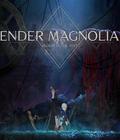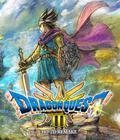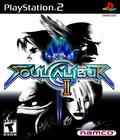Buy 'SOUL CALIBUR II': Xbox | GameCube | PlayStation 2
In a world where we all strive to live to the fullest, the central goals of Soul Calibur II make perfect sense: prove yourself and obtain the ultimate legendary sword, Soul Edge. A hero desires a sword, and a sword desires truth.
This eagerly-anticipated sequel to the famous 3D fighting game, Soul Calibur, was actually released last summer on arcade systems. The folks at Namco have been kind enough to finally bring this acclaimed game to the console systems. It’s not only a direct port of the arcade system, but each console also receives a special playable character: Xbox features Spawn, PS2 has Heihachi from Tekken, and naturally, GameCube has Link. I have not played the Xbox or GameCube versions so I will not be able to compare and contrast with the other systems; this will be a strictly PS2 review. Let the battles begin!
Whenever you ask people about Soul Calibur II on the PS2, you hear them saying that this version is the worst of the bunch. I can’t vouch for that, but I feel that the game performs perfectly fine. The gameplay moves along at a pretty quick pace: one second lost, and you may find yourself with a ring out, or even worse, allowing the opponent to score a perfect on you. There is no lag seen, even when you are pulling off the crazy combos or even the special charge moves. The only lag would be because of the characters. Generally, the larger your character is, the slower it will attack, which is obvious physics. As we all know, however, slower characters also have more raw strength and are too strong for their own good.
There are several types of characters available, but they fall into two categories: the fast characters who combo you to death or the incredibly strong ones who manage to knock you out with about three hits. Depending on the character you choose, you will play with a different style. The faster characters will have you mashing buttons like mad, while the slower characters will require that you wait for the perfect opportunity to give your opponent the fatal strike. Before you can see these openings, however, you must understand how Soul Calibur’s keys work. Controls for this game are fairly simple, with four buttons that you must use. The hand attacks would be square horizontal strike, and triangle vertical strike, hitting different parts of the body. For the legs, there is only the circle button. Perhaps the most important one would be the guard button, which if used correctly, will create openings if you correctly parry the opponent. To get the basics, I suggest you go into practice. Once you think you have a thorough grasp of the controls, it’s time to start the game.
The available gameplay modes would be: original, extra, and weapon master. Within these modes would be: arcade, versus battle, time attack, survival, team battle, versus team battle, practice, extra time attack, extra survival, extra team battle, extra practice, and weapon master, the heart of the game and the area in which I will focus all of my attention, as should you. This mode probably has the most features and the greatest perks, including unlocking large amounts of new weapons, characters, and stages. You will be going through a set storyline for each character; with most or all characters searching for the all-famous “Soul Edge,” the strongest and most powerful sword. The first few missions would be a brief introduction of how to play, learning the basics that you should have already tried in practice. You must go through severe training so you can face the famous sword and gain acceptance from it. This training will not be enough so you must go through several ordeals/objectives to truly prove that you are physically and mentally strong enough. A few fighting games include objectives, but this game probably boasts some of the most creative ones out there. Some of the conditions under which you must win are: invisible forces moving you and your opponent closer together or further apart, passing the bomb (hot potato variant), where the person who is holding the bomb at the end loses, land mines, where you will die instantly upon hitting the ground, and many more. Because of these extra conditions, it gives the battles variety rather then just constantly trying to beat down the opponent. You may think that with these conditions, it would be easier to win, but let me warn you … these objectives are not the easiest to pull off. Once you have beaten weapon mastery, you will eventually have all 23 characters with all of their costumes. It’s always great to have every character’s costume because it gives it so much more replay value in versus mode. To unlock all of the costumes, you aren’t going to be able to do it in one run you must do it in a few. If I have read correctly, you must beat weapon mastery with every single character to unlock everything, which means many, many hours of play.
The graphics quality in the game is just awesome. Once I saw the intro, I was hooked. It’s difficult to dislike an introduction that is so well-executed and contains such fine details, but if that doesn’t do it for you, then the in-game graphics will. The character models look very crisp and detailed. There is also a lot of background interaction, especially within weapon mastery mode. I just love seeing the splash whenever I knock someone into the water. The backgrounds are also very well drawn, but I don’t know if they can match VF4: Evolution’s backgrounds. However, the one thing that VF4 doesn’t have are weapons, of which Soul Calibur II has quite an abundance. Overall, the video quality is just so impressive that you can’t help but give this game a shot. The only downside is that because of this high quality video, the load time is slightly slower then it should be, but once it has loaded up, it is just eye candy for the players. If you are one of the lucky few who own a HDTV, the PS2 version supports it. Read the manual for instructions on how to activate it.
The sound in the game is also very well thought out. The intro music is just great, with a constant change of music variety, moving from several different types of instruments to match the scenes perfectly. Not only does the intro have good music, but the stages also have music that matches the fights perfectly. As for war cries, I am listening to the original Japanese language because that was how the game was meant to be heard, and the voice actors match the characters very well. Whether you’re hearing them scream because of an injury or just yelling out because they are attacking, you will never tire of it. Even before the battle you can hear a pre-game war cry by the characters if you hit one of the buttons. It’s pretty much a way to taunt your opponent and tell them to bring it on.
 This game excelled my expectations because everyone said it was the worst of the console bunch. If this is the worst, then I’m afraid to even touch the best. The game has great graphics, music, and gameplay, while being easy enough for the newbies and complicated enough for the most advanced gamers. This game is definitely near the top of my charts, and it wouldn’t surprise me in the least if this fast-paced fighter would be reissued as a platinum edition. The intense graphics make for a slightly higher load time, and you don’t automatically get to retry when you die, which is something that I would have been greatly appreciated, but those are just nitpicks. This game is definitely worth owning, but if you can’t afford this, go with VF4: Evolution, another great fighting game. For us PS2 fans, Namco has been kind enough to add an extra demo disc that includes a playable demo of I-Ninja, .Kill Switch, several video demos, and some cheat codes. So go out and prove that you are the true owner of “Soul Edge!”
This game excelled my expectations because everyone said it was the worst of the console bunch. If this is the worst, then I’m afraid to even touch the best. The game has great graphics, music, and gameplay, while being easy enough for the newbies and complicated enough for the most advanced gamers. This game is definitely near the top of my charts, and it wouldn’t surprise me in the least if this fast-paced fighter would be reissued as a platinum edition. The intense graphics make for a slightly higher load time, and you don’t automatically get to retry when you die, which is something that I would have been greatly appreciated, but those are just nitpicks. This game is definitely worth owning, but if you can’t afford this, go with VF4: Evolution, another great fighting game. For us PS2 fans, Namco has been kind enough to add an extra demo disc that includes a playable demo of I-Ninja, .Kill Switch, several video demos, and some cheat codes. So go out and prove that you are the true owner of “Soul Edge!”
Score: 9.0/10
More articles about SoulCalibur II










 A new page in history has begun as the most highly anticipated fighting game ever finally arrives! The greatest 3-D weapons-based fighter will provide non-stop action, excitement and surprises as you go one-on-one against your favorite challengers.
A new page in history has begun as the most highly anticipated fighting game ever finally arrives! The greatest 3-D weapons-based fighter will provide non-stop action, excitement and surprises as you go one-on-one against your favorite challengers.































